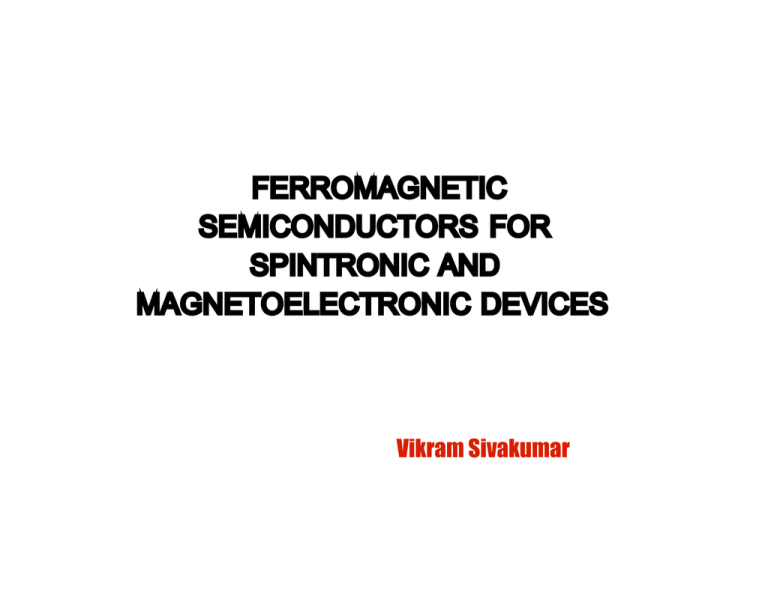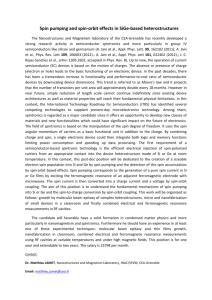Document 13562359
advertisement

FERROMAGNETIC SEMICONDUCTORS FOR SPINTRONIC AND MAGNETOELECTRONIC DEVICES Vikram Sivakumar Introduction and Overview • Moore’s Law of microelectronics – Reaching the scale-down limit • Suggestions for future: – – – – Bottom-up approach to fabrication Integration of function in devices Change in characteristics of information carrier Bioelectronics, polymer electronics, molecular electronics, spintronics What is spintronics? • • • • • Currently: Processing by charge, storage by spin, coding and transmission using photons Spintronics Information Storage + Processing Spin: additional degree of freedom Mott: Spin-polarized currents in ferromagnetic metals 10X difference between majority and minority- spin carrier currents in Fe and Co, because: – – • Splitting into majority and minority spin bands Spin-dependent cross-section of impurities Ferromagnetic proximity effect Spintronic devices • First spintronic device: spin valve based on GMR (1988) • Requirements for spintronics: – Efficient electrical injection of spin-polarized carriers – Efficient transmission during transport of carriers through semiconductor – Capability to detect or collect spin-polarized carriers – Control and manipulation of transport via external means (e.g. biasing of a gate contact on a transistor) Materials with a spin! • Ferromagnetic semiconductors – Combined semiconducting and magnetic properties for multiple functionalities – Easy growth of ferromagnet-semiconductor nanostructures – Easy spin injection: e.g. spin transistor • Half-metallic ferromagnets: 100% spin polarization – Two spin channels: one metallic, other with gap at fermi level – Examples: Extreme substitution of V, Cr and Mn into GaAs, InAs, GaSb, InSb, GaP and InP Introduction to ferromagnetic semiconductors • 1970s: Eu and Cr chalcogenides – Rock salt type EuO and EuS – Spinel type CdCr2S4 and CdCr2Se4 • Diluted magnetic semiconductors – Spins from 3d or 4f e-s of transition metal – Examples: Cd1-xCoxSe, Ga1-xMnxAs and Si:Er – II-VI compounds: tough to get a good number of mobile carriers by doping – GaMnAs: canonical DMS; Tc = 30-170 K – InMnAs: Tc=35 K – Theoretical prediction of Tc>R.T. realized in Mndoped ZnO and GaN, and in Co-doped TiO2 and ZnO – Manganites & Mn-doped IV semiconductors Theory of Magnetism in ferromagnetic semiconductors • Zener model for ferromagnetism – Ferromagnetic metals: Parallel coupling between localized spins (Heisenberg Exchange) – Quantum-mechanical treatment (RKKY): • Sign of interaction depends on distance between localized spins • Indirect exchange mechanism via charge carriers – DMS: Holes mediate between ferromagnetically coupled spins • Mn-doped III-V compounds: holes due to Mn • Mn-diluted II-VI compounds: doped with N Applicability of the Zener Model • Apply to wide-band gap semiconductors: – Short bond lengths => strong coupling between holes (anions) & spins (cations) => Large spontaneous moment – Many: Tc> R.T. but much lower moment than predicted • Fails when substitution exceeds solubility limit: – Ferrimagnetic or ferromagnetic precipitates => unaccounted magnetism ! Processing of ferromagnetic semiconductors • 1970s: II-VI by variant of Bridgeman =>spin disorder or AF coupling • Non-equilibrium processing – MBE for low-T growth of Mn-doped III-V (For single phase material at high Mn-doping, which is not possible at equilibrium) – PLD for oxides (doped ZnO, SnO, TiO2) Characterization Techniques: Spin Manipulation • GaMnAs: holes contribute to magnetism; so processes that change carrier concentration can be used for spin manipulation – Femtosecond laser pulses Spin alignment in polarized light; but precession leads to breakup; however fast laser pulses can maintain spin coherence – Electrical spin injection Quantum well structure with P-type ferromagnetic semiconductor on non-magnetic semiconductor: holes injected are spin-polarized => polarized light Characterization Techniques (Contd.) • Magneto-transport of charge carriers – Hall Effect Anomalous Hall effect due to spin-orbit coupling; electrical means of establishing weak magnetism in magnetic semiconductors – Magnetoresistance Additional term in Kohlers rule from spontaneous MR (AMR): Δρ/ρ = a (H/ρ)2 + b (M/ρ)2 Functional dependence of AMR: Δρ(H)/ ρav = Δρ/ρav (cos2θ-1/3) Example of a Hall effect measurement Image removed due to copyright considerations. See reference below. Back Hall Resistivity versus applied field for Ti1-xCoxO2-δ (The captions represent electron densities) [H. Toyosaki, T. Fukumura, et.al., Nature Materials Vol. 3 (2004) ] Potential Applications Spin valves and GMR devices Image removed due to copyright considerations. See reference below. Applications: Magnetic field sensors, read heads, galvanic isolators and magnetic random access memory [S.A. Wolf, D.D.Awschalom, et. al. Science, Vol. 294., 1488 (2001)] Magnetic Tunnel Junctions Image removed due to copyright considerations. See reference below. Non-volatile memory applications, instant turn-on computers [S.A. Wolf, D.D.Awschalom, et. al. Science, Vol. 294., 1488 (2001)] • Spin LEDs – Spin polarized charge carriers Polarized light – No need for polarizing filters Increase of efficiency • Spin FETs – Source and drain from ferromagnetic metals – Channel from semiconducting material – Additional gating action via magnetic field – Non-volatile memory due to spin polarization – Conductivity mismatch minimized by use of ferromagnetic semiconductor THANK YOU !

![HJi exp [(xb + xa) cos(wot) — 2xbx.])](http://s2.studylib.net/store/data/010971245_1-ca5a45e9550482d4b1daaee0746eb6fa-300x300.png)





